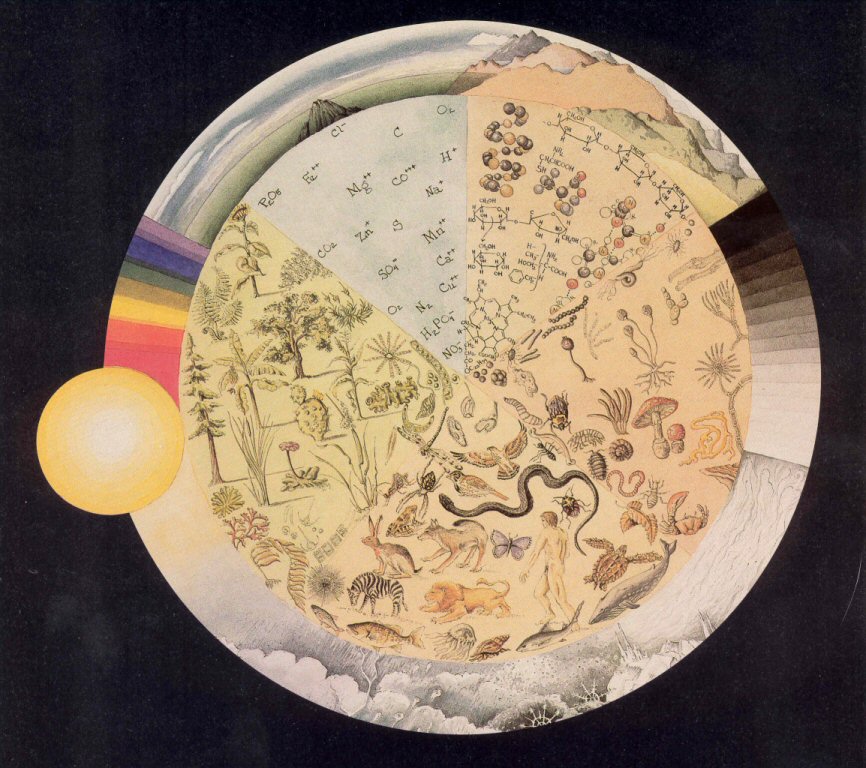
[MA149]Pages 1-29
(It may take a while to download but I think it is
worthy - John A. Keslick, Jr.) A word from the webmaster. Within
this article the word nutrient is misused at times where the true meaning is
essential elements. See my dictionary at
www.treedictionary.com and look up
nutrient as well as essential element. The reason for the latter is to
reduce misunderstanding of terms to better understand the message.
John A. Keslick, Jr.
UNDERSTANDING
THE
GAME
OF
THE
ENVIRONMENT
- - - - - - - - - - - - - - - -
AN ILLUSTRATION GUIDE
TO UNDERSTANDING ECOLOGICAL PRINCIPLES
by
David R. Houston
Northeastern Forest Experiment Station
AGRICULTURE INFORMATION BULLETIN NO. 426
UNITED STATES DEPARTMENT OF AGRICULTURE
FOREST SERVICE
WASHINGTON, D.C. SEPTEMBER 1979
THE AUTHOR
This bulletin was written and designed by DAVID R. HOUSTON, a Research Plant Pathologist with the Forest Service, U.S. Department of Agriculture, Northeastern Forest Experiment Station, Hamden, Conn. The materials presented here were developed by Dr. Houston as part of a cooperative program in which he established and taught an introductory course in ecology in 1973 and 1974 at Daniel Hand High School, Madison, Conn.
Page iv
ACKNOWLEDGMENT
David M. Carroll, Warner, N.H., provided the illustrations for
this
bulletin. Mr. Carroll, who has illustrated several Forest Service
publications, is an ardent herpetologist.
Page v
FOREWORD
Ecological concepts are not new; the term "ecology" was
coined in 1869. Derived from the Greek "oikos." or home, ecology literally
means the study of organisms in their homes.
Today we usually define ecology as the study of the relationships between
organisms and their environment-or environmental biology.
Today's energy crisis, food shortages. and population
explosion clearly indicate that basic ecological principles, once viewed as
interesting but some-what irrelevant phenomena restricted to lesser organisms
and their environment, are entirely applicable to human life as well.
The relationship of people to their environment is of ever
greater importance as the demands of a burgeoning population and the ability to
manipulate the environment increase at geometric rates.
As a supplement to other classroom materials and field experiences,
Understanding the Game of the Environment should provide stimuli for
discussion and review of ecological principles and their relevance to our daily
existence. The illustrations, purposefully detailed and complex. are
intended to provide a basis for in-depth discussion. We believe this
bulletin also should be of value to special interest and youth
organizations-members of the Youth Conservation Corps. Scouts, and others
interested in understanding their environment.
Understanding the Game of the Environment
is a summary of major ecological principles and concepts viewed
as a game in which living organisms interact with each other and their nonliving
environment. The use of game terminology helps place a bewildering array
of facts and relationships into an understandable framework. All students
are familiar with games, and they recognize the necessity of defining the
Playing Field, identifying the Players, and understanding the Rules of the Game.
Similarly, students understand that when Rules are violated and Fouls are
committed, the Players will be Penalized.
Understanding the Game of the Environment includes the:
Playing Field or
Environmental Arena (Ecosystem).
Players (The components of the ecosystem).
Rules of the Game (Ecological principles including concepts
of energy flow and material cycling).
Changing Players and Playing Fields
(Ecological succession or biotic change).
Fouls and Penalties (Stresses on the
ecosystem and their effects).
Methods of Improving the Game (Playing
within the rules).
Page vi

Page vii
CONTENTS
I. THE PLAYING FIELD: THE ENVIRONMENTAL ARENA ........ 1
II. THE PLAYERS 11
The producers 13
The Consumers 21
The Saprotrophs: Decomposer Consumers 29
Organic Compounds 33
Inorganic Substances 35
Environmental Climate 37
III. RULES OF THE GAME 38
Energy Flow Rules of the Game 39
First energy rule 39
Photosynthesis and respiration
40
One-way flow of energy 44
Second energy rule 44
Trophic level energy relationship
51
Ecological pyramids 51
Material Cycling Rules of the Game 53
Cycle pools
53
Types of cycles 53
Some Important Biogeochemical Cycles 57
The water cycle 57
The carbon cycle 58
The nitrogen cycle 60
The phosphorus cycle 66
The calcium cycle 75
The sulfur cycle 78
IV. CHANGING PLAYERS AND PLAYING
FIELDS: ECOLOGICAL SUCCESSION
80
Some Examples of Succession 82
Northern pond 82
Old field 84
Lake Michigan sand dune 86
Bare rock 88
Grassland 89
Factors Affecting Succession 91
Succession Versus Productivity 92
People and Succession 92
Page viii
V. FOULS AND PENALTIES 94
Some of
Nature's Fouls 97
Wildfire 97
Drought 98
Volcanism 99
Hurricanes 100
Overgrazing (insect defoliation)
101
Some People Fouls 105
Manipulation of ecosystems 109
Disruption of flood plains 109
Dredging and dumping 109
Growing monocultures 111
Strip mining 112
Excessive predator control 112
Depletion of finite resources
117
Agricultural land, forests, open
space 117
Minerals and metals 119
Energy reserves 119
Pollution 124
Some cycles run amuck 127
Phosphorus 127
Nitrogen 129
Sulfur dioxide 131
Heavy metals 131
Hydrocarbons (chlorinated) 132
Hydrocarbons (oil) 135
Radioactive materials 137
Solid waste 139
Sewage 139
Messing up the flow of energy 141
Heat 141
VI. IMPROVING THE GAME 146
Abiding by the Rules 147
Energy 147
Material cycling 151
Careful manipulation of Ecosystems 152
GLOSSARY OF ENVIRONMENTAL TERMS 157
Page ix
I. THE PLAYING FIELD:
THE ENVIRONMENTAL ARENA

Page 1
Figure 1. - The world, a hemisphere, a biome, a geographical region, a State, a township -all are ecosystems or environmental Arenas. But a forest, a pond, an estuary, or a shoreline is about as large an ecosystem as we can attempt to understand fully.

Page 2
The Playing Fields or Arenas where the Game of the Environment is played are the geographic units where living plants and animals interact with each other and their environment according to ecological principles that govern the flow of energy and the cycling of essential and nonessential materials. Ecologists call these Arenas ecosystems.
As a matter of fact, the entire world can be considered an ecological system or ecosystem. But the world, and especially the thin mantle of soil, air, and water I where all life exists-the biosphere-is difficult to study as a single unit because of its unwieldy size.
The continent of North America includes major regions, or biomes, that differ from each other in climate and in physiography. Biomes such as deserts, tundras, prairies, the coniferous forests of the West, and the deciduous forests of the East also differ markedly from each other in major life forms of their plants and animals. Each of these biomes can be considered an ecosystem; but even within a biome are many areas that differ significantly.
Indeed, within the limited geographic area of a single township are usually I several different kinds of ecosystems. A stream ,and its watershed, a forest, a salt marsh estuary, a freshwater pond, marsh, or swamp, a sand beach-each of these can be considered an ecosystem. These are probably the smallest ecosystems for practical consideration, though an aquarium or terrarium can be self-sustaining for a limited period (fig. 1).
Page 3
Figure 2.-Ecosystems are interrelated; what happens in one eventually affects what happens in others. What happens in the forest affects the pond, the estuary, and, finally, the ocean.

Page 4
Although ecosystems are relatively self-sustaining, they also are inseparably linked (fig. 2). Thus the nature and quality of the marine ecosystem are influenced by the materials flowing into it from the estuary, and the estuary is influenced by the materials originating farther inland. Similarly, biomes are influenced by climate - weather that is spawned or modified great distances away.
So, the processes of an ecosystem at one point on the earth's surface can affect the processes at all other points on the globe. This intimate interrelationship of seemingly diverse ecosystems has been brought sharply into focus in recent decades as pesticides and radioactive materials have spread to distant reaches of the biosphere.
Page 5
IN YOUR ENVIRONMENTAL ARENA
List some of the Playing Fields or ecosystems in your community.
Trace your community's water supply from origin through use to disposal. Does it return to nature as clean as it left?
What is the primary method of disposing of sewage in your community? Is any harm done to the environment? If so, what?
How are solid wastes disposed of in your community? If by landfills or dumps, do they create a pollution problem? How long can the community continue to use this system? Is recycling a part of the present system? Should it be? Why?
What are the major vegetational communities in your area?
What changes might have occurred in these communities in the past few decades? Why?
List any major disturbances to the land in your area.
What are the reasons for your community being established where it is? Do these reasons differ from those that might have been given by early settlers? Why?
What are the sources of energy used in your community for home heating, for industry, for agriculture? Will there be enough energy from these sources for the community as it grows? What other sources of energy would work as economically for the community?
Do you believe there is an energy crisis? Why? Why not?
Page 6

Page 7
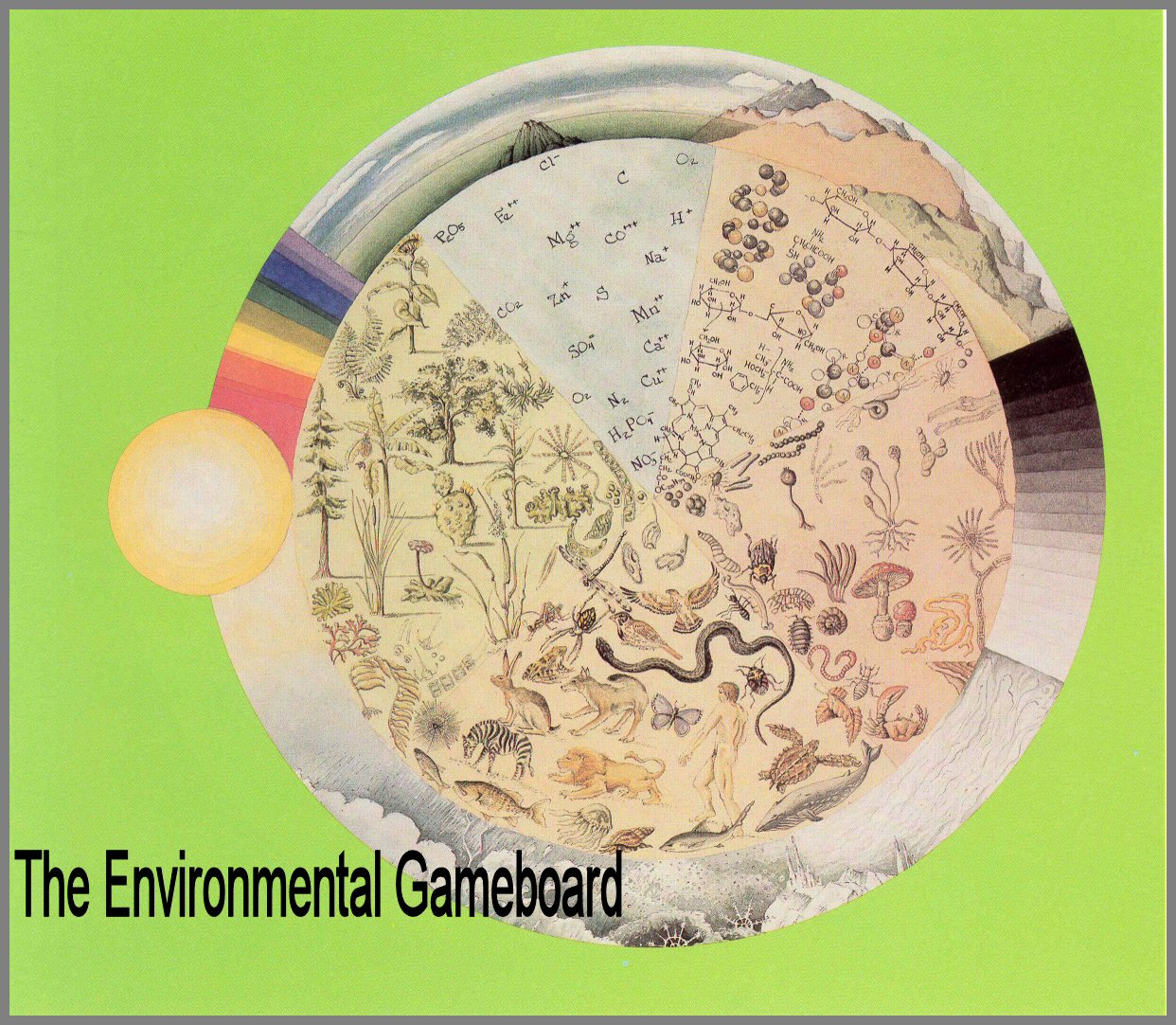
Page 8-9
Figure
3. - The Players of the Game include the green plant Producers, the animal Consumers, the macro- and micro-saprotroph Decomposers, the Organic Compounds, Inorganic Substances, and Environmental Climate.
Page 10
II. The Players
We've defined ecosystems as the Playing Fields or Environmental Arenas where living or biotic organisms interact with each other and with their nonliving or abiotic environment. These biotic and abiotic components (fig. 3) are the Players of the Game of the Environment. Included among the Players are the biotic green plant Producers, animal Consumers, and macro- and micro-saprotroph Decomposers, and the abiotic Organic Compounds, Inorganic Substances, and Environmental Climate. Like ecosystems, the Players are inseparably linked as they interact with each other.
Page 11

Page 12
THE PRODUCERS
The Producers of a pond arena are green plants (fig. 4). They include rooted plants such as cattail and arrowhead (emergents), waterlilies and pondweeds (surface plants), watermilfoils (underwater plants), and tiny floating plants or phytoplankton (algae and diatoms) (fig. 4, top of center insert).
Rooted plants are abundant in shallow water near the edge of the pond; phytoplankton are distributed throughout the water as deep as sunlight can penetrate. In most large deep ponds and lakes and in the oceans, algae are the primary Producers; yet we often overlook them and their value to the system.
Figure 4. - The green plant Producers of the Fresh Water Pond are shown
in green.
Page 13
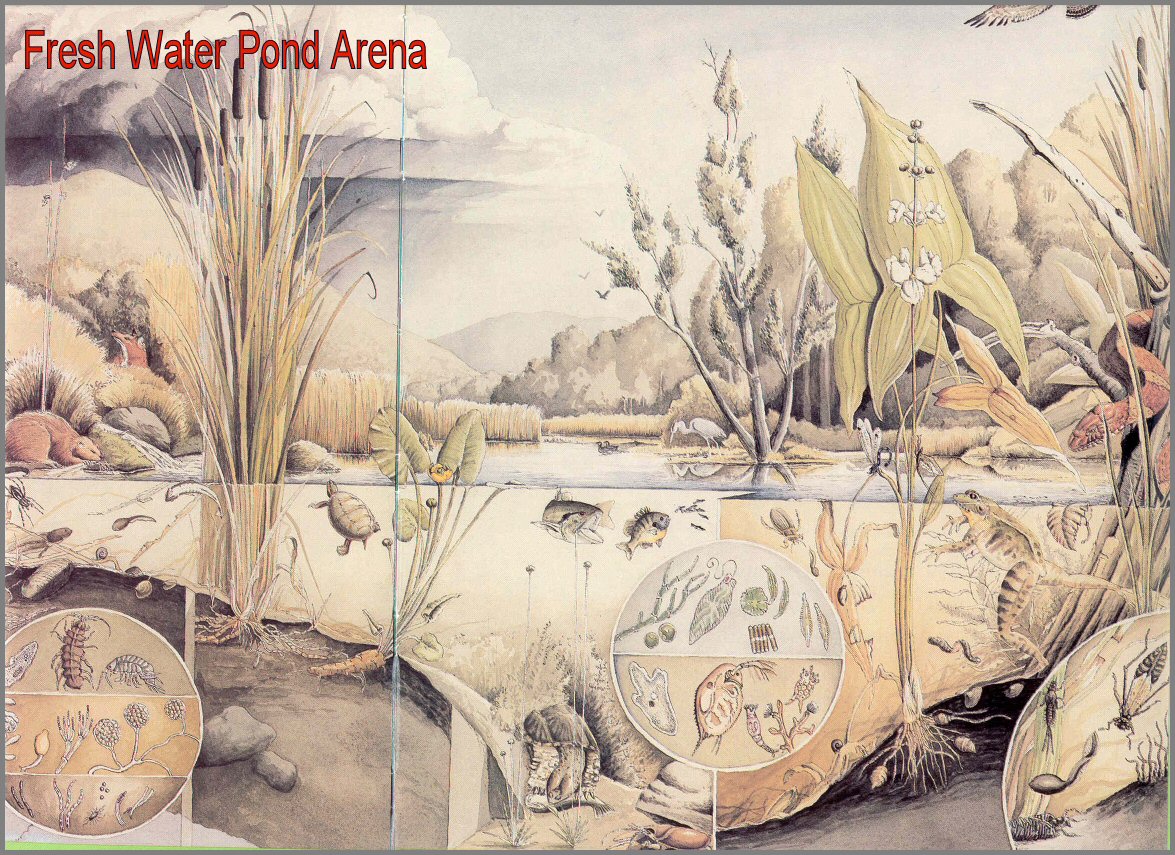
Page 14-15
In the terrestrial forest ecosystem (see Forest Arena illustration, p. 18), the Producers (fig. 5) play the same role as those in the pond; that is, they convert sunlight and carbon dioxide (CO2) into food energy-sugars and other organic compounds-to "Fuel" themselves and the other living Players of the system. The green plant Producers of all ecosystems are called, autotrophs; this means self-nourishing. All other living components of the system are heterotrophs (other nourishing); they depend on the food-making producers directly or indirectly for their sustenance:
As the Producers of the pond are stratified or arranged in layers above, on, and below the water surface, so, too, are these Players in the forest arranged in layers or strata. There are usually three layers: The ground layer that includes mosses, herbs, or wildflowers and lichens; the shrub layer, including saplings; and the tree layer above. In some forests there are many tree layers; in others, algae, mosses, and lichens grow on trunks and branches of trees far above the ground and shrub layers.
Unlike the role played by algae in the aquatic ecosystem, the role of algae in the terrestrial ecosystem is of minor importance. Here, the large rooted plants dominate, not only as food makers, but also in stabilizing and modifying the earth's surface. Actually, all rooted plants, large and small, affect the water system and the quality of the earth's surface. Another major role of vegetation is to provide shelter for the Consumers.
___ ___ ___ ___ ___ ___
IN YOUR ENVIRONMENTAL ARENA
List the Producer Players in two ecosystems of your community.
Page 16
Figure 5. - The green plant Forest Producers are shown in green.

Page 17

Page 18-19
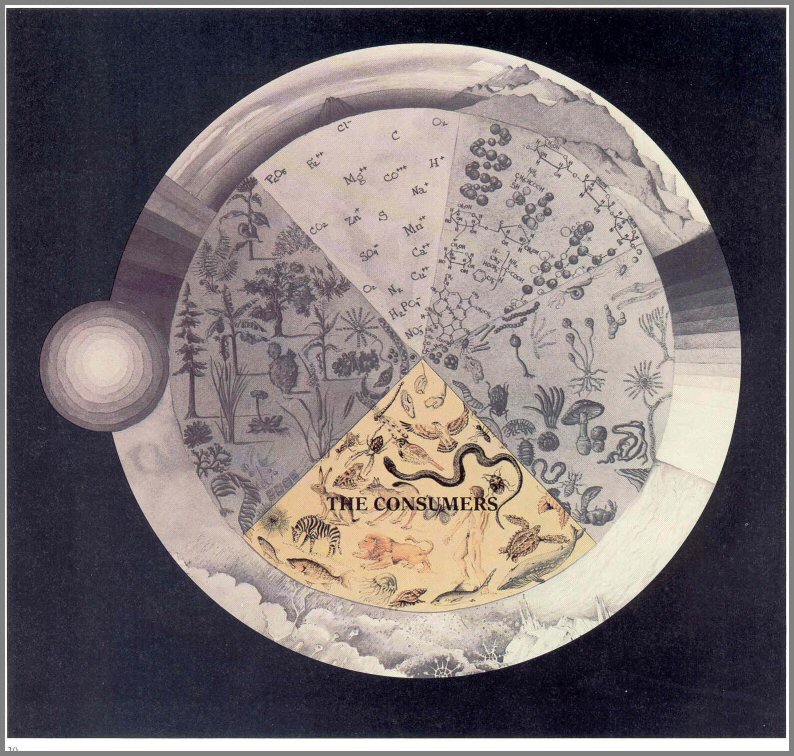
Page 20
THE CONSUMERS
The Consumer Players are the animals of the ecosystem. Animals that obtain their energy directly by grazing on plants are called herbivores; those that obtain energy indirectly by feeding on other animals are called carnivores. Some animals, called omnivores, eat both plants and animals. People are usually omnivores.
Page 21
The "grazer" herbivores of the pond ecosystem are primarily the zooplankton, or tiny floating animals (fig. 6, bottom half of insert) but they also include some insects, snails, and higher forms of life such as frog tadpoles. On a higher level, muskrats feed exclusively on aquatic plants, especially cattail; and some waterfowl are important herbivores.
Figure 6. - Some Consumers of the pond are shown in red.

Page 22
The terrestrial ecosystem contains a variety of animal Consumers. The herbivores include not only insects and small rodents but also large hoofed mammals (fig. 7). In the forest, birds can be important primary (herbivorous) and secondary (carnivorous) Consumers.
Figure 7. - A few forest Consumers are shown in red.

Page 23
Classifying these Consumers according to their value to an ecosystem as food for other animals and as consumers of food (plants or animals) is a convenient way of studying the energy relationships between predator and prey and host and parasite. Consumers, then, occupy "food" or trophic levels and consumer levels.
For example, the "grazer" herbivores occupy the next higher food or trophic level after plants; but as plant eaters, these animals occupy the primary or first consumer level.
Carnivores that feed on plant-eating animals are on the third trophic level (and the secondary consumer level). These second level Consumers, in turn, are eaten by other carnivore Consumers at still higher levels.
Page 24
This transmission of food energy from one trophic level to the next higher level is called a food chain. Food chains are often interconnected with others to form a food web. (figs. 8 and 9).
In our pond Arena, animals such as frogs and toads are herbivorous as young, but they move up one or more trophic levels as adults. In the forest, birds and mammals of prey such as owls, hawks, and foxes occupy the highest trophic levels.
In the forest ecosystem, large amounts of the "woody" material produced by plants are low in food value; however there are Consumers that digest or use this material. These Consumers make up another set of living Players-the Saprotrophs.
Figure 8. - A portion of the forest food web.

Page 25
Figure 9. - A partial pond food web

Page 26
IN YOUR ENVIRONMENTAL ARENA
List and describe the Consumer Players in an ecosystem in your area. 0 Draw a food web with as many levels as possible for your ecosystem.
Page 27
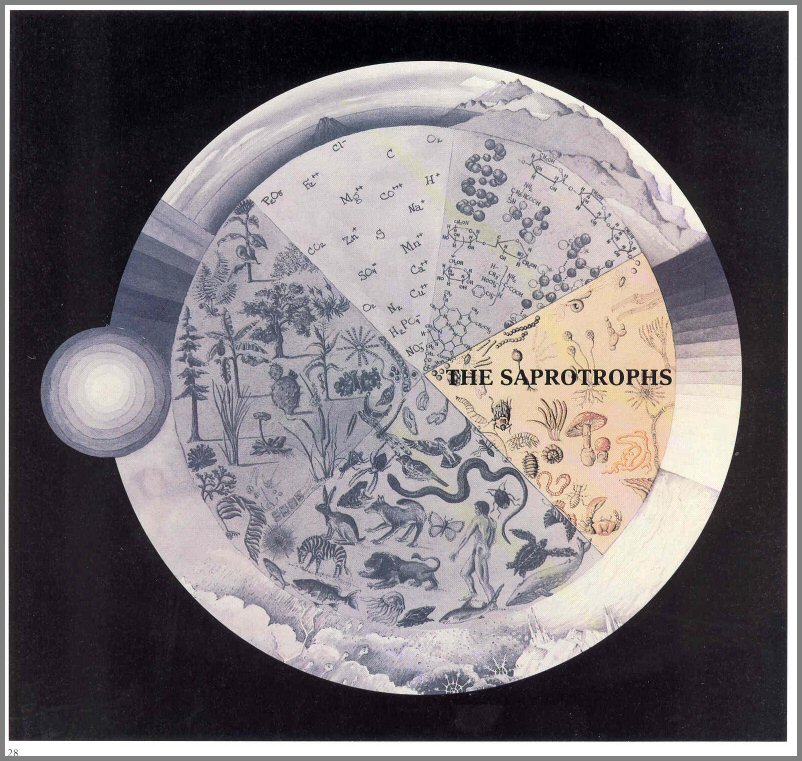
Page 27
THE SAPROTROPHS: DECOMPOSER CONSUMERS
Saprotrophs subsist on the tissue of dead animals and plants (detritus). They include macroconsumers - certain insects, worms, and snails - that feed on this detritus - and the microconsumers -organisms of decomposition such as protozoa, bacteria, fungi, and actinomycetes. The Saprotrophs are important members of all ecosystems because they break down the complex organic molecules of protoplasm and cell walls into basic components that can be used again by the Producers.
Detritus of the aquatic ecosystem is more easily "digested" than that of the land, system. In the water, therefore, the most important Saprotrophs are the macroconsumers or detritus feeders (fig. 10); the decomposer microorganisms that can digest cellulose and lignin of wood are the most important on land (fig. 11). If these organisms did not play the Game effectively, nutrients essential for growth of the plant Producers would soon be "locked up" in dead bodies and the Game of the Environment would come to an end.
---- ----- ---- ----
IN YOUR ENVIRONMENTAL ARENA
List any evidence of Saprotrophs in an ecosystem in your community.
List some of the ways that Saprotrophs are important to you in your daily activities.
Page 29